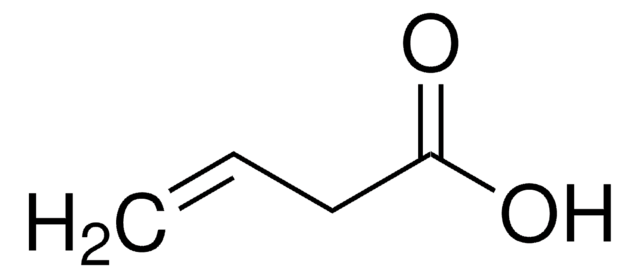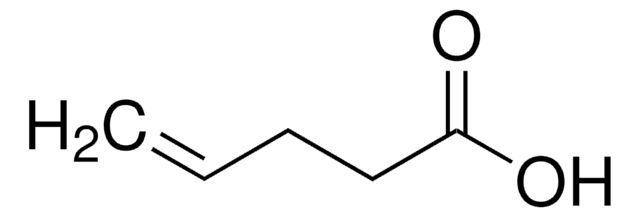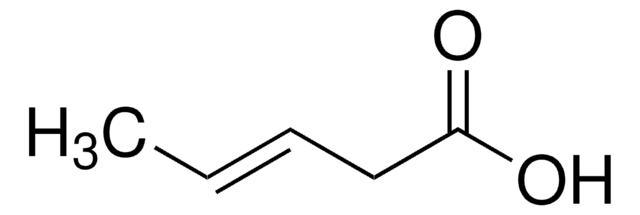All Photos(1)
About This Item
Linear Formula:
H2C=CH(CH2)3CO2H
CAS Number:
Molecular Weight:
114.14
MDL number:
UNSPSC Code:
12352100
PubChem Substance ID:
NACRES:
NA.22
Recommended Products
Quality Level
Assay
98%
refractive index
n20/D 1.435 (lit.)
bp
105 °C/15 mmHg (lit.)
density
0.961 g/mL at 25 °C (lit.)
functional group
allyl
carboxylic acid
SMILES string
OC(=O)CCCC=C
InChI
1S/C6H10O2/c1-2-3-4-5-6(7)8/h2H,1,3-5H2,(H,7,8)
InChI key
XUDOZULIAWNMIU-UHFFFAOYSA-N
Related Categories
Application
5-Hexenoic acid may be used for the preparation of iodolactone derivatives and fluorine-containing δ-valerolactones.
Signal Word
Danger
Hazard Statements
Precautionary Statements
Hazard Classifications
Eye Dam. 1 - Skin Corr. 1B
Storage Class Code
8A - Combustible corrosive hazardous materials
WGK
WGK 3
Flash Point(F)
219.2 °F - closed cup
Flash Point(C)
104 °C - closed cup
Personal Protective Equipment
dust mask type N95 (US), Eyeshields, Gloves
Choose from one of the most recent versions:
Certificates of Analysis (COA)
Lot/Batch Number
Don't see the Right Version?
If you require a particular version, you can look up a specific certificate by the Lot or Batch number.
Already Own This Product?
Find documentation for the products that you have recently purchased in the Document Library.
Customers Also Viewed
Stilianos G Roussis et al.
Journal of chromatography. A, 1594, 105-111 (2019-03-02)
In an effort to improve separation of impurities in oligonucleotide drugs, alkyl amines of different length and carbon content were evaluated as reagents in ion pair-reversed phase (IP-RP) HPLC with mass spectrometric detection. A range of columns was tested in
Tertiary aminourea-catalyzed enantioselective iodolactonization.
Gemma E Veitch et al.
Angewandte Chemie (International ed. in English), 49(40), 7332-7335 (2010-08-31)
Synthesis of fluoroalkyl-d-lactones from polyfluoroalkyl iodides and 5-hexenoic acids.
Fang X, et al.
Journal of Fluorine Chemistry, 129(4), 280-285 (2008)
Philipp Höfer et al.
Microbial cell factories, 9, 70-70 (2010-09-18)
Methylotrophic (methanol-utilizing) bacteria offer great potential as cell factories in the production of numerous products from biomass-derived methanol. Bio-methanol is essentially a non-food substrate, an advantage over sugar-utilizing cell factories. Low-value products as well as fine chemicals and advanced materials
Global Trade Item Number
| SKU | GTIN |
|---|---|
| 464929-5G | 4061832356730 |
| 464929-1G | 4061832356716 |
Our team of scientists has experience in all areas of research including Life Science, Material Science, Chemical Synthesis, Chromatography, Analytical and many others.
Contact Technical Service














